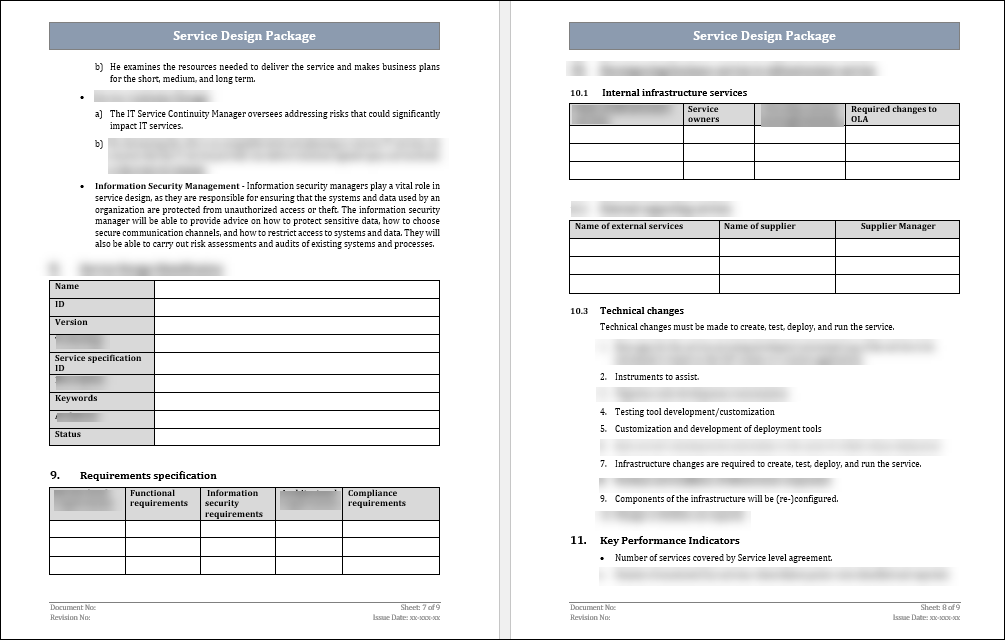Service Design Package Template
Introduction
A Service Design Package (SDP) Template in IT Governance is a detailed document that outlines the key features and specifications needed to design and deliver a specific IT service inside an organisation. It provides a structured framework for elements such as service catalogues, service level agreements (SLAs), service scope and boundaries, and service requirements and restrictions. The SDP Template promotes effective communication between IT teams and stakeholders, ensuring a shared knowledge of service design and delivery requirements. It is critical for standardising processes, improving cooperation, and eventually contributing to the successful governance of IT services by offering a uniform and well-documented approach to service design.

Importance Of A Well-Structured Service Design Package Template
A well-structured Service Design Package (SDP) Template is critical in IT Governance because it establishes clarity, consistency, and efficiency in the design and delivery of IT services. The SDP Template serves as a strategic guide for IT professionals, encouraging stakeholders to share a common understanding of service requirements by completely documenting critical features such as service catalogue, service level agreements (SLAs), and service scope. This not only improves internal communication, but it also provides a standardised framework for aligning IT services with overarching business goals, resulting in a more coherent and synergistic approach to governance.
Components of a Service Design Package Template
1. Information Security Management Policy: The Information Security Management Policy team is an essential component of the Service Design Package (SDP) Template in IT Governance. This team is responsible for developing and implementing information security policies throughout the service design and delivery process.
a) Project Team: This section describes the project team members in charge of developing and implementing the IT service.
b) SDP Checklist:
- People: Specifies the people resources needed for service design and delivery, including skill sets and roles.
- Products: A list of concrete deliverables and outputs from the service design process.
- Partners: Identifies the external entities or partners who are involved in the service design and delivery.
- Processes: This section describes the various processes and procedures used throughout the service design phase.
- Milestones: Highlights significant points or achievements in the service design timeline.
2. Key Contacts and Escalations: Identifies key individuals or contacts involved in the service design process and specifies escalation channels for problems. Ensures excellent communication channels and a system for quick issue resolution via predefined escalation paths.
3. Service Design Process Activities: This section describes the individual activities and phases involved in the service design process. Provides a structured approach to service design by directing the team through a methodical and organised series of actions.
4. Responsibilities: Clearly define each team member's roles and duties in the service design. By delegating particular tasks to individuals based on their experience and capabilities, you can ensure responsibility, reduce confusion, and foster successful collaboration.

Benefits Of Service Design Package Template
Here are the key advantages:
1. Clarity and Standardization:
- Clear Documentation: The SDP Template provides a standardised and organised style for documenting key service design features, ensuring clear communication and understanding among team members and stakeholders.
- Consistency: Standardisation across SDPs fosters consistency in service design processes, making it easier to repeat successful techniques and maintain a unified approach.
2. Improved Communication:
- Stakeholder Alignment: The template improves communication between IT teams and stakeholders by explicitly describing service design specifications, requirements, and expectations.
- Cross-functional collaboration: It encourages collaboration among the various departments and teams involved in service design, promoting a shared knowledge of roles, responsibilities, and goals.
3. Efficient Service Delivery:
- Streamlined Processes: The SDP Template defines structured processes and activities, resulting in more efficient service design and delivery.
- Risk Mitigation: The SDP Template guarantees that service design is consistent with industry standards, best practices, and compliance requirements, contributing to effective IT governance.
4. Enhanced Governance and Compliance:
- Alignment with Standards: The SDP Template guarantees that service design adheres to industry standards, best practices, and compliance requirements, hence promoting effective IT governance.
- Documentation for Audits: It creates a trail of choices, processes, and controls, making audits easier and guaranteeing that IT services meet regulatory and organisational standards.
5. Proactive Problem Resolution:
- Escalation Paths: The template's key contacts and escalation information allow for quick and effective problem resolution by outlining clear channels for dealing with concerns during service design and delivery.
- Responsibilities: Clearly defined responsibilities assist in identifying responsible parties for certain areas, expediting issue resolution, and preventing bottlenecks.
6. Resource Optimization:
- Skillful Resource Allocation: The SDP Checklist, which includes information about people, goods, partners, processes, and milestones, aids in skilled resource allocation by optimising human and material resources for effective service design.
- Reduced Redundancy: Standardised documentation eliminates redundancy and lowers the likelihood of repeating errors or oversights in service design projects.
7. Facilitation of Continuous Improvement:
- Feedback Loops: By incorporating input from ongoing service design activities, the template encourages continuous improvement and allows teams to adapt and refine their procedures over time.
- Lessons Learned: Case studies and post-implementation reviews included in the template provide useful insights, encouraging a culture of learning and growth.
Conclusion
The Service Design Package (SDP) Template is a cornerstone in the landscape of IT Governance, offering organisations an organised and complete approach to the design, deployment, and administration of IT services. The SDP Template is important because it promotes clarity, consistency, and efficiency across the service lifecycle. By clearly outlining components such as the service catalogue, service level agreements, and key contacts, the SDP Template fosters a shared language and understanding among stakeholders.

